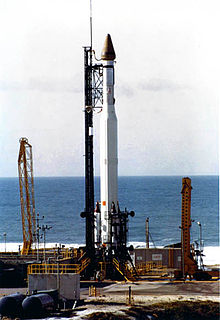 The last Thorad Agena SLV-2G with four Poppy spacecraft | |
| Manufacturer | Douglas |
|---|---|
| Country of origin | United States |
| Size | |
| Height | SLV-2G: 32.9 m (107.9 ft) SLV-2H: 34 m (111 ft) |
| Diameter | 2.44 m (8 ft) |
| Mass | SLV-2G: 91,400 kg (201,500 lb) SLV-2H: 88,731 kg (195,618 lb) |
| Stages | 2 |
| Launch history | |
| Status | Retired |
| Launch sites | Vandenberg AFB, SLC-1, SLC-2E, SLC-3W |
| Total launches | 43 (30 SLV-2G, 13 SLV-2H) |
| Success(es) | 40 (28 SLV-2G, 12 SLV-2H) |
| Failure(s) | 2 (1 SLV-2G, 1 SLV-2H) |
| Partial failure(s) | 1 (SLV-2G) |
| First flight | SLV-2G: 9 August 1966 SLV-2H: 5 June 1969 |
| Last flight | SLV-2G: 14 December 1971 SLV-2H:25 May 1972 |
Thorad-Agena was an American expendable launch system, derived from the Thor and Delta rockets.[1][2][3][4][5]
The first stage of the rocket was a stretched Thor variant named "Long Tank Thrust Augmented Thor". The Long Tank Thor first stage was later adopted by NASA's Delta program for its "Thrust Augmented Improved Delta", which first flew in 1968. The second stage was the Agena-D, which had already been used in conjunction with the standard configuration Thor, as the Thor-Agena. Three Castor rockets would be used as boosters.
Most launches carried Corona (KeyHole) reconnaissance satellites, particularly spacecraft of the KH-4 series, however some scientific and technology development satellites were also flown, mostly towards the end of the program.
- ^ "Thor Family". Gunter's Space Page. Retrieved 2023-12-09.
- ^ "Thorad-SLV2G Agena-D". Gunter's Space Page. Retrieved 2023-12-09.
- ^ "Thorad-SLV2H Agena-D". Gunter's Space Page. Retrieved 2023-12-09.
- ^ "Thor". www.astronautix.com. Retrieved 2023-12-09.
- ^ "Thorad SLV-2G Agena D". www.astronautix.com. Retrieved 2023-12-09.
